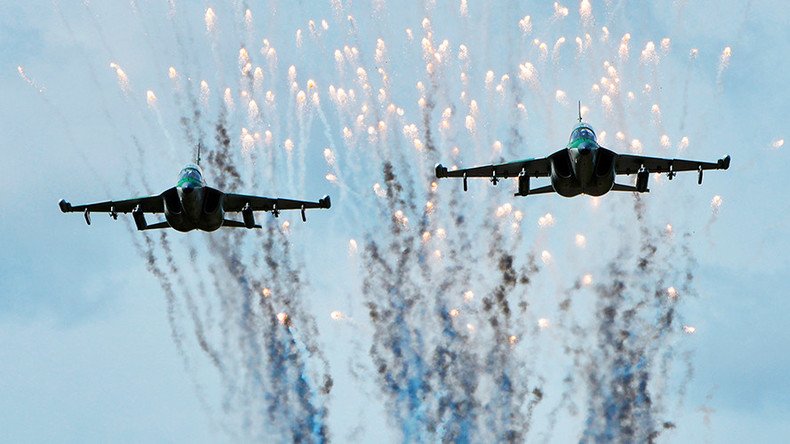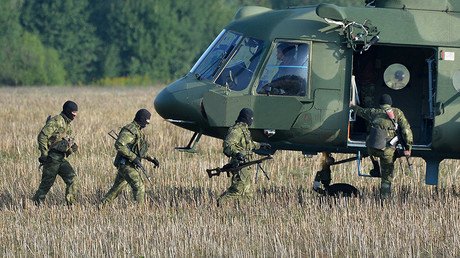Zapad 2017: Russia-Belarus drills enter 2nd stage as Sweden hosts parallel war games (VIDEOS)

Russian and Belarusian forces are striking the mock enemy on land, in the air and sea in the massive drills, which involve the full spectrum of troops, ranging from airborne armored vehicles to short-range tactical missiles.
The joint Russia-Belarus strategic Zapad 2017 drills kicked off Thursday in the two countries. Some 12,700 troops are taking part in the drills, 7,200 of them are from Belarus and 5,500 are from Russia. Some 70 military aircraft, 10 ships and 680 land vehicles, including 250 tanks, and 200 artillery pieces are also participating in the exercise.
The first part of the drills, focused on joint defensive actions, concluded Saturday. The goals included raising the troops’ readiness to the highest level amid the mock offensive, as well as deploying command centers, field stockpiles, hospitals and other military infrastructure. The troops have been honing cooperation between armies of the two countries, as well as between different military branches.
The first phase of the Zapad 2017 exercise included a spectacular massive airdrop when more than 500 airborne troops alongside with 10 combat vehicles have been deployed behind the lines of the mock enemy. The airdrop has been performed on a crumpled space in an unknown landscape. While the main force of the unit organized itself, preparing the vehicles, vanguard troops attacked the enemy from three sides simultaneously.
Missile troops, operating Iskander-M and Tochka-U tactical missile systems, have performed simulated launches against life-size targets, imitating command centers and amassed armored units of the mock enemy. The missiles were launched on targets located from 30 to 100 kilometers away, while surveillance drones monitored the accuracy of the strikes. Following the launches the missile units performed swift relocation maneuvers to avoid detection.
Ground anti-aircraft forces and aviation have been monitoring airspace, and ensuring protection of the troops from aerial attacks. During the drills, Russian and Belarusian forces tested the compatibility between electronic warfare and air defense of the two countries.
The military used for the very first time the brand new high-speed communication network, capable of transmitting large amounts of data.
The first phase of the drills concluded with large-scale joint defensive actions, which involved different types of military hardware, including tanks, infantry combat vehicles, self-propelled and towed artillery, as well as various aircraft. While fighter planes protected the skies, destroying over 30 targets imitating planes and cruise missiles of the mock enemy, attack helicopters and bombers provided support to the ground troops. The cutting-edge SVP-24 targeting system was used during the bombing runs, which ensured exceptionally high-precision strikes.
The second phase, which started Sunday, is focused on mobile defense, going into an offensive and destroying the mock enemy. The drills are simultaneously taking part on test grounds in Belarus and Russia, as well as in the Baltic Sea.
The first day of the second phase was marked with high activity of the Russian Baltic Fleet and naval aviation. Su-24 planes from the Baltic Fleet aviation provided support to the ground troops, performing strikes from various heights, ranging from 200 meters to one kilometer. The pilots have destroyed all the life-size targets, representing command centers, fortifications, troops and hardware of the mock enemy.
Deck-deployed Ka-27PL anti-submarine helicopters have performed an exercise, involving search and destruction of a mock enemy submarine. The pilots detected the submarine, using elaborate hydro-acoustic and electronic equipment and then destroyed it with naval bombs. At the meantime, Baltic Fleet ships performed live-fire drills, striking targets, which imitated enemy ships, aircraft and shore artillery.
Russia’s President Vladimir Putin is scheduled to attend the ongoing exercise on Monday.
“It is standard practice. It is the largest exercise. As commander-in-chief, Putin always attends one of its stages,” Kremlin spokesman Dmitry Peskov said on Friday.
The Zapad 2017 drills drew much attention of the NATO countries long before its start, while some media outlets and politicians fueled anti-Russian hysteria amid the upcoming drills. The accusations ranged from exaggerating the number of troops which were to participate, to ideas that the exercise was Russian cover-up to launch an invasion on the neighboring countries. Russian officials have repeatedly emphasized the defensive and anti-terrorism nature of the drills.
READ MORE: Facts vs hysteria: What you need to know about Zapad 2017 drills
“For several months, major mass media outlets around the world have been disturbing the public with myths about the Russian military threat. Politicians followed suit,” Russia’s Deputy Defense Minister Lieutenant-General Aleksandr Fomin said back in August.
“They invent the most unbelievable ways for the events to develop, some even allege that Zapad 2017 could become a launchpad for a future attack with subsequent occupation of Lithuania, Poland or Ukraine. None of these paradoxical theories has anything to do with reality, as has been repeatedly stated by Russian and Belarusian officials.”
The accusations prompted Russia and Belarus to bring transparency during the drills to a whole new level, inviting “almost anyone who wants to attend,” according to Belarus President Aleksandr Lukashenko. Latvian military inspection group, for example, visited the proving grounds in Belarus during the drills, reportedly confirming the “high level of transparency and wide openness” of the event.
The anti-Russian hysteria, which surrounded the Zapad 2017 drills, however was used by NATO countries as a pretext to beef up its military activities on Russia’s western borders. For example, Sweden is holding its largest war games in over two decades, which coincide with the Russia-Belarus drills. Apart from exceeding the number of troops participating in Zapad 2017 by several thousand, the goal of the maneuvers are openly stated as preparation for a possible “Russian attack.”













